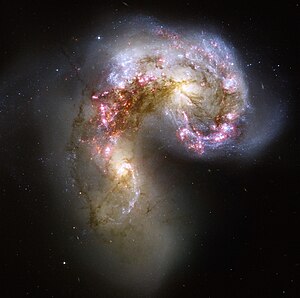Antennae Galaxies: Difference between revisions
m robot Modifying: oc:Galaxias deis Antenas |
Clammybells (talk | contribs) No edit summary |
||
| Line 25: | Line 25: | ||
}} |
}} |
||
The '''Antennae Galaxies''' (also known as '''[[New General Catalogue|NGC]] 4038'''/'''NGC 4039''' or '''Caldwell 60/61''') are a pair of [[interacting galaxy|interacting galaxies]] in the [[constellation]] [[Corvus (constellation)|Corvus]]. They were discovered by [[William Herschel]] in 1785.<ref name="universe-today">{{ cite web |
The '''Antennae Galaxies''' (also known as '''[[New General Catalogue|NGC]] 4038'''/'''NGC 4039''' or '''Caldwell 60/61''') are a pair of [[interacting galaxy|interacting galaxies]] in the [[constellation]] [[Corvus (constellation)|Corvus]]. They are currently going through a phase of [[Starburst Galaxies|starburst]]. They were discovered by [[William Herschel]] in 1785.<ref name="universe-today">{{ cite web |
||
| title=Corvus |
| title=Corvus |
||
| work=Universe Today |
| work=Universe Today |
||
Revision as of 01:56, 29 April 2011
| Antennae Galaxies | |
|---|---|
 NGC 4038 (left) & NGC 4039 (right) | |
| Observation data (J2000 epoch) | |
| Constellation | Corvus[1] |
| Right ascension | 12h 01m 53.0s / 12h 01m 53.6s[2] |
| Declination | −18° 52′ 10″ / −18° 53′ 11″[2] |
| Redshift | 1642 ± 12 / 1641 ± 9 km/s[2] |
| Distance | 45 Mly / 65 Mly |
| Apparent magnitude (V) | 11.2 / 11.1[2] |
| Characteristics | |
| Type | SB(s)m pec / SA(s)m pec[2] |
| Apparent size (V) | 5′.2 × 3′.1 / 3′.1 × 1′.6[2] |
| Notable features | Interacting galaxies |
| Other designations | |
| Ringtail Galaxy,[2] NGC 4038 / 4039,[2] PGC 37967 / 37969, Arp 244,[2] Caldwell 60/61 | |
The Antennae Galaxies (also known as NGC 4038/NGC 4039 or Caldwell 60/61) are a pair of interacting galaxies in the constellation Corvus. They are currently going through a phase of starburst. They were discovered by William Herschel in 1785.[3] NGC 4038 is located at RA 12h 01m 53.0s, Dec −18° 52′ 10″; and NGC 4039 at RA 12h 01m 53.6s, Dec −18° 53′ 11″.
General information

The Antennae are undergoing a galactic collision. Located in the NGC 4038 group with five other galaxies, these two galaxies are known as the 'Antennae' because the two long tails of stars, gas and dust thrown out of the galaxies as a result of the collision resemble the antennae of an insect. The nuclei of the two galaxies are joining to become one giant galaxy. Most galaxies probably undergo at least one significant collision in their lifetimes. This is likely the future of our Milky Way when it collides with the Andromeda Galaxy. Two supernovae have been discovered in the galaxies: SN 2004GT and SN 2007sr.
A recent study finds that these interacting galaxies are closer to the Milky Way than previously thought—at 45 million light-years instead of 65 million light-years.[4]
Timeline
About 1.2 billion years ago, the Antennae were two separate galaxies. NGC 4038 was a barred spiral galaxy and NGC 4039 was a spiral galaxy. Before the galaxies collided, NGC 4039 was larger than NGC 4038.[citation needed] 900 million years ago, the Antennae began to approach one another, looking similar to NGC 2207 and IC 2163. 600 million years ago, the Antennae passed through each other, looking like the Mice Galaxies. 300 million years ago, the Antennae's stars began to be released from both galaxies. Today the two streamers of ejected stars extend far beyond the original galaxies, making the antennae shape.
Within 400 million years, the Antennae's nuclei will collide and become a single core with stars, gas, and dust around it.[citation needed] Observations and simulations of colliding galaxies suggest that the Antennae Galaxies will eventually form an elliptical galaxy.[5]
X-ray source

Rich deposits of neon, magnesium, and silicon were discovered from the Chandra X-ray Observatory analysis of the Antennae Galaxies. These elements are among those that form the building blocks for habitable planets. The clouds imaged contain magnesium and silicon at 16 and 24 times, respectively, the abundance in the Sun.
See also
References
- ^ R. W. Sinnott, editor (1988). The Complete New General Catalogue and Index Catalogue of Nebulae and Star Clusters by J. L. E. Dreyer. Sky Publishing Corporation and Cambridge University Press. ISBN 0933346514.
{{cite book}}:|author=has generic name (help) - ^ a b c d e f g h i "NASA/IPAC Extragalactic Database". Results for NGC 4038 / 4039. Retrieved 2006-12-07.
- ^ "Corvus". Universe Today. Retrieved 2006-12-07.
- ^ "The Antennae Galaxies Found To Be Closer To Us". Space Daily. 2008-05-12. Retrieved 2008-06-30.
- ^ J. E. Barnes, L. Hernquist (1992). "Dynamics of interacting galaxies". Annual Review of Astronomy and Astrophysics. 30 (1): 705–742. Bibcode:1992ARA&A..30..705B. doi:10.1146/annurev.aa.30.090192.003421.
External links
- Astronomy Picture of the Day: The Antennae Galaxies (10/22/1997)
- The Register: Galactic prang fingered in star formation mystery
- ESA/Hubble News Release
- ESA/Hubble images of Antennae Galaxies
- Antennae Galaxies on WikiSky: DSS2, SDSS, GALEX, IRAS, Hydrogen α, X-Ray, Astrophoto, Sky Map, Articles and images
